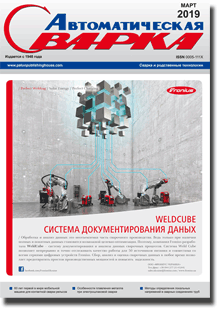| 2019 №03 (01) |
DOI of Article 10.15407/as2019.03.02 |
2019 №03 (03) |

Avtomaticheskaya Svarka (Automatic Welding), #3, 2019, pp. 18-22
Effect of repeated heating in multi-pass submerged arc welding on resistance of welded joints of rotor steel to delayed fracture
V.Yu. Skulskyi1, S.I. Moravetskyi1, M.A. Nimko1, Yu.G. Pashchenko2, A.G. Kantor2, V.V. Dmytryk3
1E.O. Paton Electric Welding Institute of the NAS of Ukraine. 11 Kazimir Malevich Str., 03150, Kyiv, Ukraine. E-mail: office@paton.kiev.ua
2JSC «Turboatom». 199 Moscow Ave., 61037, Kharkov, Ukraine. Е-mail: office@turboatom.com.ua
3NTU «Kharkov Polytechnic Institute». 2 Kirpicheva Str., 61002, Kharkov, Ukraine
On the example of the 0.25C-2CrNiMoV rotary steel joints, produced by submerged arc welding using the Implant method, the change in resistance to delayed fracture depending on the temperature of preheating and thermal effect during deposition of new beads was experimentally studied. The nature of change in hardness in the cross-section of quenching steel with surfacing was investigated, which illustrates the formation of quenching and tempering areas under the influence of repeated welding heating. Using critical stresses as a quantitative indicator, causing a delayed fracture, it was shown that after repeated welding heating, the resistance to cracking can increase by about 1.5...2.5 times or more. In the conditions of welding without preheating, repeated one-time and two-time cycles of welding heating increase the resistance to cracks up to the level obtained during welding with preheating up to 150...200 °C. 9 Ref., 4 Fig.
Key words: heat-resistant rotary steel, submerged arc welding, quenching, repeated welding heating, Implant, resistance to delayed fracture
Received: 28.11.2018
Published: 20.02.2019
References
1. Lobanov, L.M., Mikhoduj, L.I., Pivtorak, V.A. et al. (1995) Influence of peculiarities of submerged-arc welding technology on stress state of high-strength steel welded joints. Avtomatich. Svarka, 9, 21-23 [in Russian].2. Burashenko, I.A., Zvezdin, Yu.I., Tsukanov, V.V. (1981) Substantiation of heating temperature in welding Cr-Ni-Mo-V steels of martensitic class. Ibid., 11, 16-20 [in Russian].
3. Novikov, I.I. (1971) Theory of heat treatment. Moscow, Metallurgiya [in Russian].
4. Skulsky, V.Yu. (2009) Weldability of heat-resistant steels for boiler units of high parameters: Syn. of Thesis for Dr. of Techn. Sci. Degree. Kyiv, PWI [in Ukrainian].
5. Tsaryuk, A.K., Skulsky, V.Yu., Moravetsky, S.I. (2016) Mechanized narrow-gap submerged-arc welding of thick-walled cylindrical products. In: Proc. of 2nd Medovar Memorium Symp. (June 7-10, 2016, Kyiv, Ukraine). Kyiv, Elmet-Roll.
6. Skulsky, V.Yu., Strizhius, G.N., Nimko, M.A. et al. (2019) Delayed fracture resistance of welded joints of rotor steel 25Kh2NMFA after welding reheating. The Paton Welding J., 2, 7-12. https://doi.org/10.15407/tpwj2019.02.01
7. Kozlov, R.A. (1986) Welding of heat-resistant steels. Leningrad, Mashinostroenie [in Russian].
8. Skulsky, V.Yu. (2009) Thermokinetic peculiarities of formation of cold cracks in welded joints on hardening heat-resistant steels. The Paton Welding J., 3, 8-11.
9. Oring, H., Shuetz, H., Klug, P. (1996) Vorwaermen aus Sicht des Schweissgutes bei hoch- und warmfesten Schweissverbindungen. Schweisstechnik, 1, 4-8 [in German].
The cost of subscription/purchase order journals or individual articles
| Journal/Currency | Annual Set | 1 issue printed |
1 issue |
one article |
| TPWJ/USD | 384 $ | 32 $ | 26 $ | 13 $ |
| TPWJ/EUR | 348 € | 29 € | 24 € | 12 € |
| TPWJ/UAH | 7200 UAH | 600 UAH | 600 UAH | 280 UAH |
| AS/UAH | 1800 UAH | 300 UAH | 300 UAH | 150 UAH |
| AS/USD | 192 $ | 32 $ | 26 $ | 13 $ |
| AS/EUR | 180 € | 30 € | 25 € | 12 € |
| SEM/UAH | 1200 UAH | 300 UAH | 300 UAH | 150 UAH |
| SEM/USD | 128 $ | 32 $ | 26 $ | 13 $ |
| SEM/EUR | 120 € | 30 € | 25 € | 12 € |
| TDNK/UAH | 1200 UAH | 300 UAH | 300 UAH | 150 UAH |
| TDNK/USD | 128 $ | 32 $ | 26 $ | 13 $ |
| TDNK/EUR | 120 € | 30 € | 25 € | 15 € |
AS = «Automatic Welding» - 6 issues per year;
TPWJ = «PATON WELDING JOURNAL» - 12 issues per year;
SEM = «Electrometallurgy Today» - 4 issues per year;
TDNK = «Technical Diagnostics and Non-Destructive Testing» - 4 issues per year.





